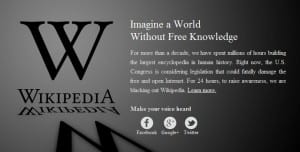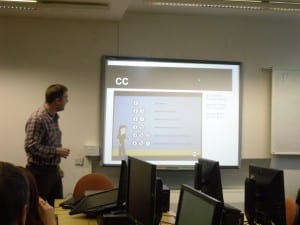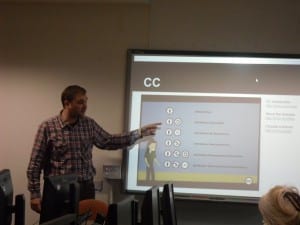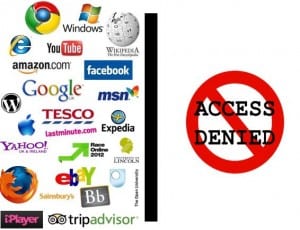In February 2012 the RNIB held a Hackathon event. Android, iOS and HTML5 developers came together to find out more about the importance of accessible apps and to talk to blind and partially sighted users to find out what really matters to them when it comes to mobile apps. The developers worked through the night to collaboratively build programmes and applications that could make a difference in the app market. Watch this video to see some of the outcomes. As Steve Jones from the RNIB Innovation Team says – for people with visual impairment the outcomes of events like these are life transforming.
 Author: Sue Watling
Author: Sue Watling
Creative Commons Licensing
Part of the Team Six Workshop, OER, Copyright and Licencing, looked at Creative Commons licences. Creative Commons is the infrastructure built to allow content creators legal controls over the copyright of the their work. More information about Creative Commons can be found on the Creative Commons site and the Lincoln Academic Commons site at http://commons.lincoln.ac.uk/creative-commons There are six different Creative Commons licences, each one giving the conditions under which the content can be shared, re-designed and re-licenced either commerically or non-commercially. Each licence can be identified with a relevant logo.
Attribution. CC BY. This licence means other people can use and reuse the OER, including commercially, as long as the original author is credited. This licence is recommended for ensuring content is most widely shared.
Attribution ShareAlike. CC BY SA. This license includes the same criteria as Attribution but anyone re-purposing it must license the new materials under identical terms.
Attribution-NoDerivs. CC BY ND. This license allows for commercial and non-commercial redistribution but it cannot be changed and the original author is credited.
Attribution-NonCommercial. CC BY-NC. This license is for non-commercial use. It allows others to re-use and re-purpose content. The original author must be cited but the new work does not have to be licenced under identical terms.
Attribution-NonCommercial-ShareAlike. CC BY-NC-SA. This license is for non-commercial use. It allows others to re-use and re-purpose content. The original author must be cited and the new work must be licenced under identical terms.
Attribution-NonCommercial-NoDerivs. CC BY-NC-ND. This is the most restrictive license. Work can be downloaded and shared, the original author must be credited but not changes can be made and the work must not be used commercially.
The Creative Commons site contains more information about background and development of these licence and also has a licence choosing tool designed to help you select the right licence for your own work.
Because the creator has the control over the copyright, sharing and distribution of their work, this is sometimes referred to copyleft.
Taking a risk with copyright
OER Copyright and Licenses was the first Embedding OER Practice workshop run by Paul Stainthorp, Julian Beckton and Joss Winn. The session introduced the complexities of copyright legislation. In a world where the internet has become the first destination of choice when it comes to creating teaching and learning content, it offers an infinite source of materials and there are many common myths about their usage
- “It’s OK if it’s in a closed environment like Blackboard.”
- “If people put things (e.g. images) on the WWW, they can’t mind me using them.”
- “No-one’s going to sue the University over it.”
All of these are incorrect. It’s worth bearing in mind that in the copyright world everything belongs to someone. So although taking and reusing online content is easy, there are a complex set of rules and regulations to be aware of. Unfortunately there is also no single answer as to what can or cannot be taken but some guidelines are more fixed than others. For example you can reuse content if:
- You are the originator therefore you have the copyright
- You have the permission from the originator to reuse their materials
- The materials have a creative commons licence stating they are freely available
- The content is covered by a university licence to be used
- The content copyright has expired (usually a 70 year time span)
- The amount copied is not considered substantial
- You can claim a defence of fair dealing
The last two are where the complexity begins. Substantial is undefined. For example a square taken from the face of the Mona Lisa would be more substantial than the same sized square taken from the bottom right of the picture. The face would be more recognisable than her dark clothes so has a different significance in terms of copyright legislation. The defence of fair dealing is also an arbitrary ruling. While the work of others can be copied for criticism or review – e.g. teaching and learning – we can’t rely on this as a defence in law that the action was justified. There is no exception to copyright for education purposes in the UK as there is in other countries and the concept of fair dealing is less applicable in law than is often realised. When we take content there is always a risk and individuals have to consider the level of that risk.
Everything belongs to someone. A colleague gave the useful example of wanting to use the London Underground tube map in a book and having the publishers request permission. London Transport agreed but with restrictions on the artwork and a fee of £300. This applies to logos and trademarks and was relevant to me – when I talk about the digital divide I use the slide below.
How illegal is this? What is the risk level of stealing all these logos for educational purposes? Scary stuff if only because this illustrates how easy it is to do this without thinking through the potential consequences.
What all this does do is reinforce the value of Creative Commons licences which will be looked at next.
Mental illness diagnosis widened to include ‘uncertainty over gender’
The celebration of diversity and difference continues to be erased from social history. The new edition of the DSM-5, Psychiatry’s behaviour classification manual, suggests the parameters of social control are continuing to remove responsibility for behaviour from the individual to the state. The DSM has always been controversial, not least because of the relationship between naming behaviours as symptomatic of mental illness and drug production; ADHD and Ritalin being a prime example. New labels in the DSM-5 (due out in May 2012) include shyness in children, loneliness, grief and serial rape. Each one of these deserves attention, not least because of their un-holistic nature, but the one which horrifies me the most is the possibility that uncertainty over gender could be labelled a mental illness.
Sex and gender identity is still informed by a cursory glance towards the genitals at birth. There is no routine testing for chemical imbalances such as complete or partial androgen insensitivity syndrome in spite of hormones being the key triggers of foetal development from female to male. Intersex is an established medical condition and any search on ‘Gender Dysphoria’ will evidence the medical acceptance that individual ‘uncertainty over gender’ deserves scientific attention not any drug induced ‘normalisation’ process.
The movement towards acceptance of transgender identity, e.g. the lobbying group Press for Change, has empowered transgendered individuals to live authentic lives. This is how it should be. Identity is a fundamental component of our lives and history is full of horror when this clashes with social imperatives for order and control. The disjuncture between internal and external gender perception needs support. The worry is labeling gender dysphoria as a mental rather than a physical condition will mean it becomes a process of ‘normalisation’ rather than one which addresses its physiological roots.
RNIB sues BMIBaby for its inaccessible website
The Web Access and Inclusion for Disabled People A Formal Investigation was conducted by the Disability Rights Commission in 2004. Amongst its findings were 81% of sites failed to satisfy the most basic Web Accessibility Initiative category and website designers had an inadequate understanding of the needs of disabled users and how to create accessible websites. Many websites had characteristics that made it difficult, if not impossible, for people with certain impairments, especially those who are blind, to make use of the services provided.
Not much has changed. Working with people with sight loss I would say all the websites we try to access are, if not fully inaccessible (like iTunes) have sections (such as payment pages) which remain inaccessible to screen readers. In 2005 the RNIB issued this statement
“A disabled person can make a claim against you if your website makes it impossible or unreasonably difficult to access information and services. If you have not made reasonable adjustments and cannot show that this failure is justified, then you may be liable under the Act, and may have to pay compensation and be ordered by a court to change your site.”
The Act they were referring to was the Disability Discrimination Act 1995 (now superceded by the Equality Act 2010). To date there have been two cases of website inaccessibility which the RNIB have taken to court – each one settled out of court and the names of the companies not revealed.
Last week the RNIB launched a case against Bmi-baby for their inaccessible website. It’s unusual for the company to be identified in this way – but it’s what needs to happen. Until there is a test case and inaccessible websites are shown to be illegal then people will carry on with bad practices and users of assistive technology will continue to be digitally excluded.
Change Academy Start-up Meeting
Today is the start of a HEA Change Academy programme. This is part of the Embedding OER Practice in Institutions project here at the University of Lincoln. The project is looking at the philosophy and practice of open education and the use and reuse of OER and embedding that practice across the whole institution. The Change Academy is about supporting institutional change by working with staff and students to create those conditions most conducive to change. Engagement with OER is part of a much wider picture of the use of technology for learning which includes VLEs, Web 2.0 style tools and social media –as well as familiarity with the open education movement in general and open educational resources in particular. Even higher and wider to this is the individual need for confidence and competence working within digital environments and understanding what makes effective digital learning experiences. All of this involves change – in particular the adoption of digital literacies – those skills and understandings which are essential to teaching, learning and professional practice in a digital age. The Change Academy will help ensure individual project outcomes can be sustainable and identify ways for embedding them at departmental and Faculty level while overall project guidance to OER practice within teaching and learning aims to bring in all other academic and professional support staff from across the university. Watch this space for further developments…
SOPA and PIPA; be aware and be prepared to fight…
If you haven’t heard of SOPA today is a good time to look it up. Try Wikipedia today (18 January) and you will be directed to information about SOPA and PIPA instead.

Briefly the 24 hour blackout by Wikipedia and a number of other web presences is in response to proposals by the US Congress – the Stop Online Piracy Act (SOPA) and the PROTECT IP Act (PIPA) – which are designed to control user generated content. This is allegedly about infringement of copyright. Instead of reviewing existing copyright legislation in the light of an Internet age, the media giants have chosen to reinforce their monopolies with a cast iron boot approach. This directly opposes the original ‘openness’ of the Internet while hiding behind claims of piracy and thievery aimed at users who are refusing to be customers. Google, Twitter and EBay are also allegedly opposing this legislation although not with Blackouts – maybe they should – but at least two of the three carry advertising.
The fear is the US will have the power to control information and close any websites which contain disputed copyrighted materials. Should it come about I suspect DRM will inevitably be extended as commercial companies use this as an opportunity to protect their brands and products. Capitalism is fighting back and the only surprise is that it has taken this long. There are two issues; firstly the debate over copyright itself and secondly the exposure of the frailty of our digital connections. We take them for granted but they are more vulnerable to attack than we realise. Once the ways and means of imposing controls begins then the Internet will become just another commodity and all its potential for democratic access will be lost. These attempts to control the Internet should be opposed.
For more information see See Stop SOPA Now! by Dan Gilmour and Wikipedia Blackout Looms b Mark Sweeny.
2012 is going to be an exciting year…
See my post on Embedding OER Practice for more details about the HEA/JISC funded project to look at the use of open educational resources for teaching and learning. Here are some more reasons why this is going to be an exciting opportunity to put the spotlight on virtual teaching and learning experiences. Embedding OER Practice will draw attention to the role of online learning across the university as well as highlighting the effective use of digital resources. The project will promote the advantages of the open education movement and support staff in becoming more familiar with terms like Creative Commons, Lincoln Academic Commons, public copyright licences, Shuttleworth Foundation, Capetown Open Educational Declaration and the accessing and contributing to repositories of learning content
As well as offering experience with finding, evaluating, using, repurposing and replacing open educational resources, the project is an ideal opportunity for addressing the wider issues around supporting the digital literacies of staff and students.The term digital literacies is popular at the moment. The JISC Developing Digital Literacies programme is currently funding a number of projects across the sector, all aimed at promoting digital literacies strategies and approaches. This is a necessary step forward. For too long those with technical competence have made assumptions about those without. The result is a widening digital divide, exacerbated by a determinist view of technology having transformative potential, not only for access to learning environments which cross barriers of time and distance, but to cut costs and increase efficiency. All this underpins investment in the digital teaching and learning platforms promoted across the sector as a means for institutions to achieve key strategic aims (HEFCE 2005, 2009*). The missing element from these grand schemes has always been the human one; how best to scaffold support for the necessary changes in attitudes, behaviours and practice. Promoting digital literacies is an ideal way to address these issues full on.
The term digital literacies is defined as ‘the confident and critical use of ICT for work, leisure, learning and communication‘ or ‘the ability to locate, organize, understand, evaluate, and analyze information using digital technology’. Focusing on the embedding OER practice offers multiple opportunities to ensure digital literacies is on the agenda – and from there it is a small step to include awareness of exclusive and inclusive practices with digital environments and critical reflection on the boundary lines between private/personal and public/professional online identities and behaviours.
Oh yes, 2012 is going to be a very exciting year!
| Follow the OER project blog here http://oer.blogs.lincoln.ac.uk |
* Higher Education Funding Council for England (HEFCE) (2OO9) Enhancing learning and teaching through the use of technology. A revised approach to HEFCE’s strategy for e-learning.
* Higher Education Funding Council for England (HEFCE) (2OO5) Enhancing learning and teaching through the use of technology.
Embedding Open Educational Resources (OER)
Embedding Open Educational Resources (OER) Practice in Institutions is a £50,000 project funded under the HEFCE/JISC/HEA OER Programme: Higher Education Institutional Change (HEIC) Strand. The aim of the project is to support Open Educational Resources (OER) policy and practice as a whole institution approach here at the University of Lincoln. Six project teams have been set up to look at how OER can be used to support different aspects of the student experience and I will be coordinating their progress over the next year. The six project areas are:
- Supporting Transition with OER
- Using OER to introduce the processes of reflection/critical thinking in Year One Semester One.
- Exploring the use of OER for embedding ‘employability’ in the undergraduate curriculum.
- OER and e-portfolios for students and practice educators or mentors on undergraduate and postgraduate work-based learning award.
- Exploring and embedding the use of OERs on PGCert/HE…and beyond.
- Project Six: Behind the Scenes: supporting OER as a whole institution philosophy.
Alongside scoping, using and repurposing OER, the HEA will run an internal Change Academy programme at Lincoln. This process includes specific development opportunities for the team leaders and an ongoing support network for all team members. The Change Academy programme supports both rapid innovation and capacity-building for longer-term change and aims to provide creative environments to focus on planning and developing strategies for lasting change. This will be an excellent way to expand the outcomes and successes of individual projects across the wider departments and Faculties while working towards the institution wide adoption of the philosophy and practice of OER. In doing so there will also be opportunities to surface the associated digital literacies requirements of students and staff and address inclusive digital practices. A win-win situation!
Further details about the programme can be found at the project blog http://oer.blogs.lincoln.ac.uk
Not being pedantic – but an important distinction
I’m writing this because of a blog post I saw yesterday which claims to reveal social charity incomes e.g.
- Scope – 101 million pounds
- Mencap – 194 million pounds
- RNIB – 135 million pounds
- Leonard Cheshire – 155 million pounds
Unfortunately, this isn’t referenced. However, the Charity Commission for England and Wales reveals a total annual income of all registered main charities exceeding £26billion and that seems to be a lot of money. However, the real rationale for this post lies in the accompanying text. Still unreferenced but I know it echoes current research e.g. the Scope ComRes survey showing attitudes to ‘disabled’ people have deteriorated , and the recent report uncovering disability hate crime No Hiding Place. So although there are no sources, I’m quoting from the blog directly.
- There is a stigma associated with being labelled as ‘disabled’;
- Being labelled disabled can impact on your ability to get, and keep, a job;
- Being disabled is not seen in any way as a positive personal attribute by the wider society.
How do you read these statements? I think they contain a potential ambiguity which is damaging to the individuals concerned. The word disabled is described as being attached to the person by a label. You can label something without it necessarily being correct or appropriate, so this isn’t necessarily calling the person disabled, but what is missing is the next stage where the reader needs to be reminded we are disabled as much by a hostile environment and social attitudes as by our diversity or difference.
The Disability Rights Movement called for a Social Model of Disability to replace the existing Medical Model. They wanted to show how we are disabled by external barriers – in the built environment and in cultural attitudes and misconceptions – which fail to cater for a broad enough range of diversity and difference. This approach does not deny the reality of impairment – it is about calling for social change in order to reduce barriers to access and participation and a starting point is the language we use.
I know it sounds pedantic but there are key differences between the phrase ‘being disabled’ and ‘being disabled by society’. It’s an important distinction and one which needs to be kept in mind.


